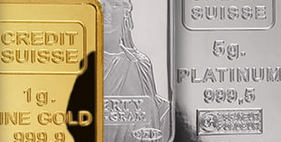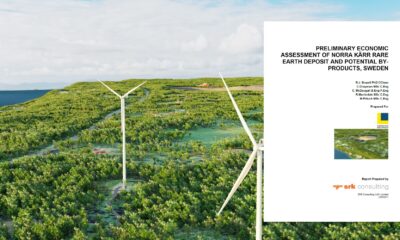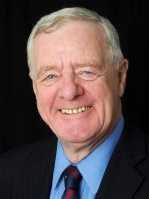Nyheter
David Hargreaves on Precious Metals, week 15 2014

We dwell in platinum this week, because unless the South African government takes a grip on its problems that metal will truly spotlight. See below. But platinum tracks gold, not vice-versa. This week gold put on 1.6% and is up 5.2% on the year to date. No big deal compared with its 24% 2013 fall eh? The drivers, which we stress to the point of boredom are, and will remain, the economic and military-political. The former is worth its 1-3% short term move and this week did not disappoint. We expect interest rates to rise, probably slowly, so that is a damper.
We expect the world economy to pick up, so that is another. Both good reasons for WIM to look at a $1200/oz base. The political military is out of our hands. Vladimir does not always answer the phone, so probably plotting his stealthy creep into the Ukraine. Both Egypt and India look like settling their elections peacefully and a knee-jerk towards $2000 plus does not look imminent. As for RSA, we increasingly care less, don’t we?
Palladium limped to its highest level since 2011, at $788/oz as the US threatened sanctions against Russia. Rum stuff this. The sister metal to platinum sells cheaper because it is not so efficient as a catalyst, but sort-of OK. So half price. It is more loved by diesel engines than petrol engines too. Here is how it stacks up:
Palladium Supply and Demand
- World Demand. c. 9,000,000 oz
- World Mined output. c. 6,500,000 oz
- Recycling and disinvestment. c. 2,500,000 oz
Major producers: Russia 44%, RSA 41%, North America 9%, other 6%. So Russia, thanks to its by product output from Norilsk Nickel, has a firmer foot print in the palladium market than it does in platinum. It also has had a major stockpile whose current status remains unknown. If the US decides to impose Ukrainian-related sanctions it could affect supplies. The major US producer Stillwater (SWC.N $15.52; Hi-Lo $16.03-9.80) produces about 6% of total world mined output.
Still on sanctions, Russia’s Polyus Gold may delist from the London market because of the threat of sanctions. A clutch of other companies could be affected including Uralkali, Polymetal, Highland Gold, PhosAgro. Petropavlovsk does not have a London listing.
South Africa’s platinum problems. The unions will lose this one. Platinum numbers favour the companies, not the unions. Are we missing a trick? Although it is a precious metal in all respects, it differentiates itself from Au in being largely an industrial one. About 50% is used in autocatalysts, which turn noxious exhaust fumes into harmless water vapour and nitrous oxides. Such a device lasts for about 50,000 running miles, but can then be recycled. So the numbers go like this:
- World demand for platinum in all forms: 7,700,000
- Investment demand 7% 550,000
- Autocatalyst demand 50% 3,850,000
- Recycling 900,000
- New production autocatalyst demand 2,950,000
- ETF Stockpiles: c. 2,000,000
- Industrial stockpiles annualised shortfall or zero production 500,000oz
- Weeks auto supply from stockpiles 44
Now you do not get a much better politico-economic fit than that which RSA has with platinum. But it is light years away from being able to exploit it because its industrial relations are a shambles matched only by its unattainable expansionary goals based on a deteriorating power supply. All this in election year.
The platinum industry problems began when a brand new workers’ union, AMCU, set up in opposition to the established NUM and demanded a doubling of wages. After 10 weeks of strikes the companies have offered 9% and adopted a take-it-or-leave-it attitude. Being South Africa this can turn bloody. The companies are at pains to assure their customers that they can meet their demands for the foreseeable future and on the above numbers would appear to have some justification.
Should it drag on, much will depend on the attitude of the exchange traded funds (ETFs) towards selling. The largest, RSA’s NewPlat ETF may have a dilemma but New York based Physical Platinum will suffer no such problems. Those two have over 1.5Moz which we suspect will come out at the right price. So industry looks ok for the next 44 weeks.
Not so the strikers and their families. There is little public sympathy for this strike but if the ANC government does not show its hand it will soon turn violent. President Zuma cannot surely endorse a doubling of wages can he? The man is well paid to be leader; now he must earn his keep.
Charity chapter two. A city colleague suggested, tongue-in-cheek this week, that following Rio Tinto’s lead, Amplats might donate its RSA operations to charity. The rationale, we think, was that they are rapidly becoming more trouble than they are worth. Let the locals see if they can make a go of where the London-tainted majors are failing. Well, hey presto, black-led Sibanye Gold has made a fist out of picking up high cost old gold mines on the Reef and is turning them to account. Now we hear it has made contact with Amplats about buying its high cost Rustenburg shafts. We will report more when we know more.
[hr]
About David Hargreaves
David Hargreaves is a mining engineer with over forty years of senior experience in the industry. After qualifying in coal mining he worked in the iron ore mines of Quebec and Northwest Ontario before diversifying into other bulk minerals including bauxite. He was Head of Research for stockbrokers James Capel in London from 1974 to 1977 and voted Mining Analyst of the year on three successive occasions.
Since forming his own metals broking and research company in 1977, he has successfully promoted and been a director of several public companies. He currently writes “The Week in Mining”, an incisive review of world mining events, for stockbrokers WH Ireland. David’s research pays particular attention to steel via the iron ore and coal supply industries. He is a Chartered Mining Engineer, Fellow of the Geological Society and the Institute of Mining, Minerals and Materials, and a Member of the Royal Institution. His textbook, “The World Index of Resources and Population” accurately predicted the exponential rise in demand for steel industry products.
Nyheter
Gruvbolaget Boliden överträffade analytikernas förväntningar

Gruvbolaget Boliden överträffade analytikernas förväntningar med bred marginal när man presenterade resultatet för det tredje kvartalet. Mikael Staffas, vd för Boliden, kommenterar kvartalet och hur han ser på råvarumarknaden och bolagets olika gruvprojekt.
Nyheter
Australien och USA investerar 8,5 miljarder USD för försörjningskedja av kritiska mineraler

USA:s president Donald Trump och Australiens premiärminister Anthony Albanese undertecknade på måndagen ett avtal som ska tillföra miljarder dollar till projekt inom kritiska mineraler.
Länderna kommer tillsammans att bidra med 1-3 miljarder dollar till projekten under de kommande sex månaderna. Den totala projektportföljen är värd 8,5 miljarder dollar, enligt regeringarna.
Galliumraffinaderi med kapacitet för 5x USA:s efterfrågan
Som en del av avtalet kommer det amerikanska försvarsdepartementet även att investera i ett galliumraffinaderi i västra Australien med en kapacitet på 100 ton per år. För närvarande importerar USA omkring 21 ton gallium, vilket motsvarar hela den inhemska konsumtionen, enligt den amerikanska geologiska myndigheten.
Initiativet kommer samtidigt som Kina har infört exportrestriktioner på vissa mineraler, däribland sällsynta jordartsmetaller, som är avgörande för tillverkningen av elektronik och elmotorer. Gallium används till exempel i mikrovågskretsar samt blå och violetta lysdioder (LED), vilka kan användas för att skapa kraftfulla lasrar.
Nyheter
Vad guldets uppgång egentligen betyder för världen

Guldpriset har nyligen nått rekordnivåer, över 4 000 dollar per uns. Denna uppgång är inte bara ett resultat av spekulation, utan speglar djupare förändringar i den globala ekonomin. Bloomberg analyserar hur detta hänger samman med minskad tillit till dollarn, geopolitisk oro och förändrade investeringsmönster.
Guldets roll som säker tillgång har stärkts i takt med att förtroendet för den amerikanska centralbanken minskat. Osäkerhet kring Federal Reserves oberoende, inflationens utveckling och USA:s ekonomiska stabilitet har fått investerare att söka alternativ till fiatvalutor. Donald Trumps handelskrig har också bidragit till att underminera dollarns status som global reservvaluta.
Samtidigt ökar den geopolitiska spänningen, särskilt mellan USA och Kina. Kapitalflykt från Kina, driven av oro för övertryckta valutor och instabilitet i det finansiella systemet, har lett till ökad efterfrågan på guld. Även kryptovalutor som bitcoin stiger i värde, vilket tyder på ett bredare skifte mot hårda tillgångar.
Bloomberg lyfter fram att derivatmarknaden för guld visar tecken på spekulativ överhettning. Positioneringsdata och avvikelser i terminskurvor tyder på att investerare roterar bort från aktier och obligationer till guld. ETF-flöden och CFTC-statistik bekräftar denna trend.
En annan aspekt är att de superrika nu köper upp alla tillgångsslag – aktier, fastigheter, statsobligationer och guld – vilket bryter mot traditionella investeringslogiker där vissa tillgångar fungerar som motvikt till andra. Detta tyder på att marknaden är ur balans och att kapitalfördelningen är skev.
Sammanfattningsvis är guldets prisrally ett tecken på en värld i ekonomisk omkalibrering. Det signalerar misstro mot fiatvalutor, oro för geopolitisk instabilitet och ett skifte i hur investerare ser på risk och trygghet.
-

 Nyheter4 veckor sedan
Nyheter4 veckor sedanOPEC+ missar produktionsmål, stöder oljepriserna
-

 Nyheter2 veckor sedan
Nyheter2 veckor sedanGoldman Sachs höjer prognosen för guld, tror priset når 4900 USD
-

 Nyheter3 veckor sedan
Nyheter3 veckor sedanBlykalla och amerikanska Oklo inleder ett samarbete
-

 Nyheter3 veckor sedan
Nyheter3 veckor sedanGuld nära 4000 USD och silver 50 USD, därför kan de fortsätta stiga
-

 Nyheter2 veckor sedan
Nyheter2 veckor sedanLeading Edge Materials är på rätt plats i rätt tid
-

 Nyheter2 veckor sedan
Nyheter2 veckor sedanNytt prisrekord, guld stiger över 4000 USD
-

 Nyheter3 veckor sedan
Nyheter3 veckor sedanEtt samtal om guld, olja, koppar och stål
-

 Analys3 veckor sedan
Analys3 veckor sedanOPEC+ will likely unwind 500 kb/d of voluntary quotas in October. But a full unwind of 1.5 mb/d in one go could be in the cards












